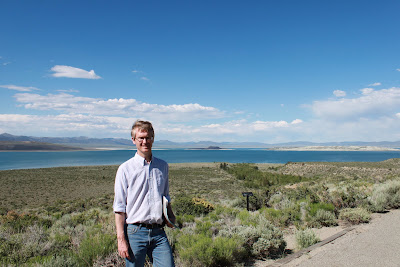
On the road from Sacramento to Mono Lake, we traveled the back of the Sierra Nevada. Lots of tall mountains and pine trees.
 It was very windy sometimes.
It was very windy sometimes.Here at one of our stops is Zulita back in the car trying to stay away from the wind, but the wind still has her hair:-)
 We were glad to finally take our first glance at Mono Lake at a view point on the road.
We were glad to finally take our first glance at Mono Lake at a view point on the road.Mono Lake is located to the immediate east of Yosemite National Park. Mono is the western most basin of the Basin and Range province, which stretches across western North America Between the Rocky Mountains and The Sierra Nevada, In the heart of the basin lies Mono Lake.
It is surrounded by different kind of terrains. The 13,000 ft. peaks of the Sierra Nevada to the west, the ancient volcanic Bodie Hills to the north, a vast of rolling stagebrush to the east and young Mono Craters to the south.

Mono Lake is one of the oldest lakes in North America, it has fluctuated in size over the years. Mono Lake has no outlet. For thousands of years streams have carried minerals into the lake and evaporation has removed water from it. As a result of this process, the mineral content has risen and the lake has high salt concentration, the lake offers a delightfully buoyant swimming experience.
Gordon and the lake
We did a Mono Lake Tufa tour. Highly recommended to anyone that visits the this lake. It helps to understand and appreciate how unique, interesting and special this Lake really is. Also learn about the history of this lake, how it came to be and what California is doing to preserve it.
 What is Tufa?
What is Tufa?
Tufa tower formations show what nature can do with a few basic elements. The strange spires and knobs are formed when fresh water springs containing calcium bubble up through the carbonate-rich lake water. The combination of these waters forms calcium carbonate, a whitish limestone deposits that forms the basis of the tufa formations. Tufa is found in many alkaline lakes throughout the world.
 What is Tufa?
What is Tufa?Tufa tower formations show what nature can do with a few basic elements. The strange spires and knobs are formed when fresh water springs containing calcium bubble up through the carbonate-rich lake water. The combination of these waters forms calcium carbonate, a whitish limestone deposits that forms the basis of the tufa formations. Tufa is found in many alkaline lakes throughout the world.
 Our guide demonstrated how Tufa rock formations are formed.
Our guide demonstrated how Tufa rock formations are formed.Our guide made some Tufa for us by taking water form the lake and mixing it with mineral found in the soil of this area.
 The water in the glass turned white intermediately and a small Tufa rock started to form at the bottom of the glass.
The water in the glass turned white intermediately and a small Tufa rock started to form at the bottom of the glass.
 This is a picture of Gordon with a few leaves from the bush next to him in his hands. Here he is just before he tasted the leaves and found they were terribly salty. Should have take a picture of his face as he ate his leaves.
This is a picture of Gordon with a few leaves from the bush next to him in his hands. Here he is just before he tasted the leaves and found they were terribly salty. Should have take a picture of his face as he ate his leaves.Our tour guide told us all about the plants adaptation of this area. The plants and bushes around the lake are salty because water on the ground of this area has a lot of salt. Our tour guide had us all take a small peace from the plants there and eat it, it was amazingly very salty to the taste.
 Our tour guide told us all about the small shrimp and the water flies that live on this lake and also let us go in the water to find them. People that had water shoes were able to go in the water and find them. Pretty fun!
Our tour guide told us all about the small shrimp and the water flies that live on this lake and also let us go in the water to find them. People that had water shoes were able to go in the water and find them. Pretty fun!This is a dead lake, but small shrimp and water flies live in the water. The shrimp eats the algae in the lake to live. The water flies come up to land to find food. Then the migrating birds stop here every year and eat the shrimp and flies and double their wait before they migrate back all the way to Chile to mate. Very interesting!
 People in our tour looking in the water and taking out specimens they found and then sharing them with the rest of the group.
People in our tour looking in the water and taking out specimens they found and then sharing them with the rest of the group. This looks like dirt floating on the water, it is not they are clusters of water flies, alkali flies that live on the lake and lake shores.
This looks like dirt floating on the water, it is not they are clusters of water flies, alkali flies that live on the lake and lake shores.The Native Americans that lived here were called Kutzadika's Monache, meaning "fly-eaters". These natives collected the abundant alkaly fly pupae and used them as one of their main food sources. Monoche was shorten to "Mono" and applied to the region and people living here by early explorers in the 1850s. This is how this lake got his name of Mono Lake.
 Came to an area where there were springs of water on the edge of the lake.
Came to an area where there were springs of water on the edge of the lake.Zulita looking closely at one of the springs that feeds the lake. We got to waked among the water springs there. It was fun!
 This trail lead to were there was a beach area where they let you swim on the lake, but we did not come prepared with bathing suits. It would have been fun to swim in such salty water and float since the salt level of this lake is very high. Swimming in Mono Lake has to wait until next time we come:-(
This trail lead to were there was a beach area where they let you swim on the lake, but we did not come prepared with bathing suits. It would have been fun to swim in such salty water and float since the salt level of this lake is very high. Swimming in Mono Lake has to wait until next time we come:-(
We were very hungry so we left the lake and went to eat at a place near the lake.
Fish-mango tacos for dinner!

Gordon was hungry. He sure was happy with his fish mango tacos.
Even that it was getting cold, we decided to eat at the outside tables because the restaurant had a view of the lake. We wanted to see the sunset at the lake, but we soon found out that the sunset had already happened and we missed it.
 View of the lake as we ate. We wanted to see the sunset but the sunset sets over the Sierra Nevada Mountains to the west (the opposite direction from this picture) an hour earlier and then there is like an hour of twilight on this area before it gets dark. This picture is facing east with Mono Lake and the eastern mountains during the twilight time.
View of the lake as we ate. We wanted to see the sunset but the sunset sets over the Sierra Nevada Mountains to the west (the opposite direction from this picture) an hour earlier and then there is like an hour of twilight on this area before it gets dark. This picture is facing east with Mono Lake and the eastern mountains during the twilight time.














 Posted by
Posted by











0 comments:
Post a Comment